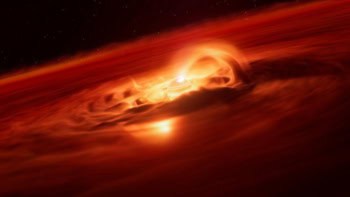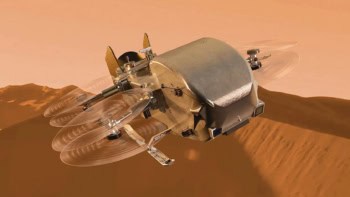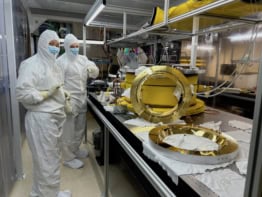
Astronomers have obtained what could be the first direct image of a planet orbiting a star much like the Sun. The planet is about eight times the mass of Jupiter and appears to be in an extremely large orbit around the star. The discovery could “pose a serious challenge to theories of star and planet formation”, the researchers say.
Since the first extrasolar planet (or exoplanet) was discovered in 1995, astronomers have detected over 300 such “companions” orbiting stars other than the Sun. Most exoplanets have been discovered by looking for tiny changes in the starlight itself — a small dip in the brightness of a star when an exoplanet crosses between it and Earth, for example.
However, it has not been easy to actually “see” exoplanets with a telescope because the star usually far outshines the relatively dim light from the planet. Those few exoplanets that have been imaged directly tend to be very large bodies (some are even classified as brown-dwarfs) that orbit relatively dim stars much smaller than our Sun.
Direct image
Now, Marten van Kerkwijk and colleagues at the University of Toronto have used the Gemini North telescope in Hawaii to obtain a direct image of an exoplanet orbiting a star called 1RXS J160929.1-210524. Lying about 500 light-years from Earth, the star is about as big as our Sun (arXiv:0809.1424).
The trick to successful direct imaging, according to van Kerkwijk, is to concentrate on young stars because they tend to be dimmer than their older cousins. The star in question, which is only about 1000-times brighter than the exoplanet, was seen with the help of “adaptive optics” that corrects for the blurring of Earth’s atmosphere.
A curious feature of the system that made it easier to image is that the exoplanet is about 330-times the Earth-Sun distance from the star. While the astronomers are pleased with their find, they are also puzzled by how the planet could have formed so far from the star.
Two stars or one?
According to conventional theories of star and planet formation, there are two ways that the system could have come about. It could have formed like a binary star with the smaller star somehow shrinking to become a planet. While in line with the large separation between the two bodies, this explanation cannot account for the star being 1000 times heavier than the exoplanet: such a large discrepancy is extremely rare in binary stars, according to van Kerkwijk.
On the other hand, the large mass of the exoplanet is in line with models of planet formation. The problem then, according to van Kerkwijk, is that the planet is too far from the star. Conventional theories of planet formation suggest that such young stars do not have enough material to form a planet so far out — and even if this star did, formation at that distance would take longer than the estimated age of the exoplanet.
One solution to this dilemma is that the exoplanet formed nearer to the star and somehow wandered further out — perhaps by interacting with debris orbiting the star. While such “wandering giants” are not unheard of — most astronomers believe that they move in the opposite direction, forming some distance from the star and then moving inwards.
“I don’t really know how to choose between the two [theories of formation] and believe that either is possible,” said van Kerkwijk.
Looking for more planets and debris
To get a better idea of how the planet formed, the team is now looking for other planets and debris around the star. As well as using existing telescopes, van Kerkwijk and colleagues hope to use the new wide-field camera to be installed on the Hubble Space Telescope next month. The team also plan to use Gemini’s Near Infrared Coronagraphic Imager (NICI), which will be available next year.
And van Kerkwijk admits that there is a slight possibility that the two bodies are not actually orbiting each other — and it is just a coincidence that they appear in the same place in the sky. To confirm that the bodies are locked in orbit will take further observations.



